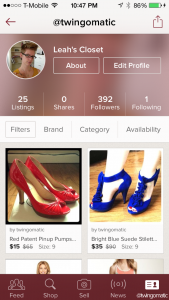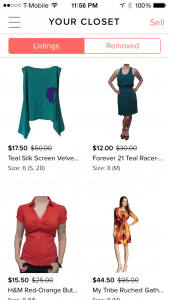As regular readers may have figured out, I do a lot of shopping. It seems I have a new dress or bra to review on here every week. But I also mention quite often the fact that I live in New York City, land of the tiny, closet-less apartments.
So where do I store all these dresses?? Well I actually have a limited number of hangers, and when they all get full, instead of buying more hangers I get rid of a dress or two. But when you spend so much time searching for dresses to fit your boobs, it’s hard to get rid of them! They’re so difficult to find and often expensive. Selling the nicer ones instead of donating to goodwill is one way that encourages me to make room in the closet, and over the years I’ve discovered several avenues for doing so. This week, I’ll give an overview of four methods, and what I like and dislike about each.
First up, the most casual: Selling through Facebook groups.
I often mention Facebook forums where I get advice on busty clothing, and several of those same forums are also a venue to swap and sell my boob-friendly castoffs. I’m a member of a Trashy Diva group, a general big boobs clothing group, and used to be on a few others such as Hell Bunny and Wheels & Dollbaby. These days, I’m just on the first two because they’re the best organized and have moderators who keep everyone on topic and keep an eye out for scammers.
In both groups, there are official photo albums organized by size, into which one can post the item for sale and write details about fit, condition, and price. Some people also simply post their available items to the wall, but in that case it can disappear under more active conversations, so I like to stick with the albums.
When someone is interested, they usually start out by commenting on the photo, and then if they decide to move forward with the purchase, the conversation will move to private messages. Thanks to Paypal, sending and receiving money is very easy and everything goes directly between seller and buyer without any middlemen and just a small Paypal fee.
Speaking of Paypal fees, there are two options for sending money. Sending as a “gift” and using your bank account (as opposed to a credit card) will incur no fees. Sending (or requesting) money as payment for goods and services incurs a small fee (about 2.5% or so). It would be nice to stick with the gift method, but it’s much safer to accept the fees and send as official payment. If there’s a problem with the item you purchase or it’s never received, you can open a dispute with Paypal and get a refund. You can’t open a dispute for a “gift,” though.
Some ladies in these groups get to know one another quite well and feel comfortable enough to do business with the “gift” function, but if you’re a new buyer or seller, I’d definitely recommend sticking with the fees.
Selling Method #2: eBay
I’ve been using eBay for about a decade, so I know it quite well at this point and feel very comfortable using it. It gives you a much wider potential selling base than a Facebook group does, but it’s also not as targeted an audience and there are thousands (millions?) of other people selling on there, so it’s hard to make your listings stand out. As such, it’s difficult to sell items that aren’t from a well-known brand. And with well-known brands, it’s more likely that there will be other people selling the same thing, which means you may not be able to command as high a price as you’d like, depending on the prices of similar items.
There are also a lot of annoying buyers on eBay who don’t follow the rules, doing things like asking for a lower price after winning an auction, simply not paying because they changed their mind, or even receiving the item and then lying about its condition to get a refund. Unfortunately, in recent years eBay has strengthened its buyer protections significantly whilst decreasing its seller protections.
For example, it used to be that both buyers and sellers could choose to leave positive or negative feedback. It’s since been changed so buyers can choose positive, neutral, or negative, but a seller can only choose positive or “report this buyer.” You can write a negative comment even while selecting “positive,” but there’s no way to select “negative” overall, and as a result it’s impossible for buyers to have anything but 100% positive feedback in terms of numbers. You have to go out of your way to report a buyer for violating eBay’s terms, and even then they’ll only get kicked off if they do it repeatedly. There’s no good way to warn other sellers that a particular buyer is bad news.
As a buyer, though, you can certainly take comfort in the fact that eBay will almost always rule in your favor should a dispute arise.
All that being said, eBay is extremely intuitive and easy to use. You simply click “sell” and follow the instructions step-by step. They want you to sell your items, because that’s how they make money—by taking a 10% cut of each sale. There are listings fees as well, but the first 50 or 100 (depending on category) per month are free, so that doesn’t affect small-time sellers like me. Payment is once again sent and received through Paypal.
EBay offers three kinds of listings: auction, buy-it-now, or auction with a buy-it-now option. For items that I expect to sell quickly (such as popular brands, or anything just before Christmas), I stick with auction and usually include a buy-it-now option for a higher price. For items by a lesser-known brand, I select just buy-it-now and leave the listing up indefinitely. You can choose the duration of each listing from as little as a few days, to a month, to “until it sells,” as I do with my buy-it-now listings.
One final tip: As a seller, you can offer a range of shipping carriers and speeds. I always go for USPS because it’s the cheapest for small parcels, but I often roll the cost of shipping into the price of the item and then offer “free shipping” (especially when I plan to use a Priority flat-rate box, because then I know exactly what it’ll cost no matter where I ship it or how heavy it is). People just love free shipping (or what they think is “free” shipping), so it can really boost your sales to offer it. I used to avoid doing that because it meant eBay was technically getting a cut of the money intended to pay for shipping, but they changed their policy a couple years ago and now they take a cut of the entire final value, shipping and all, so it makes no difference.
The third (and fourth) method: Shopping Apps
Shopping apps are smartphone applications or websites where sellers list their pre-owned clothing. The app takes a cut of each purchase, but also dictates the same shipping rate no matter the size or cost of the item, and provides sellers with a shipping label. There are no auctions, but buyers can message you to make an offer for a lower price or ask for a bundle of several items to avoid paying the shipping fee several times over.
I’m currently using two shopping apps, one of which I just signed up for recently. The one I’ve been using for a year or so is the smartphone app Poshmark. It has a very easy-to-use interface and is really fun for browsing and searching. I’ve wasted many an hour flicking through other people’s items, and once in a while you can find a real gem, like the pinup brands we’re all familiar with, for rock bottom prices.
Poshmark lets you submit up to four photos of your item, you select a category, and then you write your own title and description. They take a 20% cut, which is twice that of other sites. But Poshmark also only charges buyers $4.99 for shipping via USPS Priority.
They also host “Closet Clear-Out” events pretty frequently, during which time if you drop the price of an item by at least 10%, everyone who has “liked” it will receive an alert letting them know, and they’ll be able to get a shipping discount for an hour after the price drop. Again the program wants you to sell, sell, sell! since that’s how they make their money. There are no listings fees or ads.
I’ve bought and sold a handful of items through Poshmark, but to be honest I really expected to sell more stuff more quickly. I do better on eBay. I have several items with dozens of “likes” and plenty of comments, but they’re still languishing in my virtual closet months later.
One thing you can do to get more eyes on your items is to submit them to “parties,” which happen three times a day and always have a theme. The themes range from vague (“girly girl party”) to totally specific (“Nike, Puma, and Lululemon party”). You can also “follow” sellers, much like Facebook, and then “share” new listings to your followers. Other people can also share your items to their followers, so it helps to like items, leave comments, and follow other sellers.

The final app I’ve used to list clothes is called Tradesy. I actually haven’t explored the phone app much, but have listed lots of items through the website. While Poshmark only allows you to sell through the app (you can browse and buy through the site, though), Tradesy has an excellent website with full functionality.
Tradesy works much the same as Poshmark, but there are some key differences. First, they only take a 9% cut (again with no fees or ads). They have a higher shipping rate of $7.50 and will actually mail you a shipping kit complete with box and label when you sell something. No scrounging around for an old box or envelope! You select the box size from a dropdown when you list the item.
They also alter everyone’s main photo, to take out the background and replace it with a white field, and remove the hanger if it’s been photographed while hung up. This way, all the images across the entire app look consistent. They also allow you to upload up to eight photos, instead of Posh’s mere four.
I haven’t purchased or sold anything through Tradesy yet, so I can’t speak to that experience, but I really love their website interface. It’s so easy and intuitive to list things, and they even give you pricing suggestions based on similar items that have sold and the original price of the item.
Overall, I like using Tradesy better for listing things, but I like Posh better for buying, since I think the browsing, community, and communication experiences are better (and they offer cheaper shipping).

All the different selling outlets have their pros and cons depending on personal preferences and what you’re selling. I prefer to use all four since it makes it that much more likely that my items will sell (though some garments are not appropriate for all forums). It might sound like a lot of work, but if you list the item (or a few items) in all the outlets at the same time, it’s quick and easy. Just copy and paste all the same info across each platform!
Finally, in case anyone is interested in checking out my for-sale items, my eBay username is SailorM17 and in the two apps it’s Twingomatic.
Happy selling!